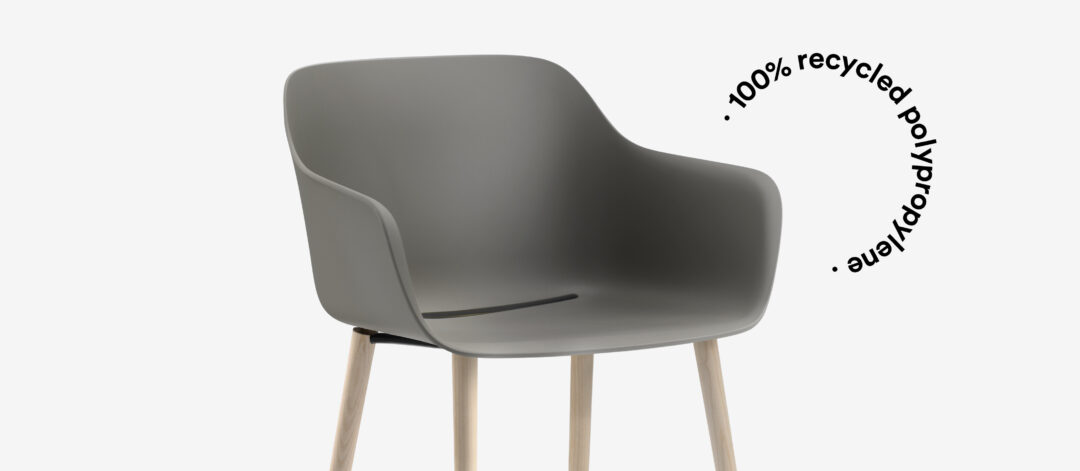Recycled Grey
Innovation overview and development
An overview of the sustainable innovation
Recycled Grey is the name of the recycled polypropylene finish of the collections launched by Pedrali, 50% from plastic material post-consumer waste and 50% from plastic material industrial waste. Plastic material post-consumer waste comes from products that have been used and then duly recycled by consumers, such as plastic bottles or food packaging. The industrial element of the company’s new 100% recycled material comes from plastic waste, containers and films. All the products made from this new sustainable material share a characteristic grey hue, a neutral colour chosen to even out and conceal any imperfections typical of recycled materials. Given the name of “recycled grey”, the products are marked with the pad-printed inscription “100% recycled”, to emphasize their eco-friendliness.
How the innovation was developed, including effective collaboration, knowledge transfer and partnership along the project team
This blend allows to manufacture high quality green products with excellent mechanical performance. Obtaining 50% of this material from post-consumer waste means selecting, sorting and recovering a material that would otherwise be discarded. Instead, by conducting precise tests and analyses, we can create the ideal raw material for use in furniture. Pedrali has identified 50% of post-consumer waste as the ideal blend to guarantee high quality products featuring the high resistance and durability levels required of contract furniture, given its substantial and prolonged use. To ensure these properties, the furniture made from recycled polypropylene is subjected to resistance tests to prove they can withstand prolonged exposure to light and temperatures between +50°C and -10°C without effects. Moreover, the furniture’s antistatic finishes are easy to clean, to maintain, and – more importantly, given the ongoing pandemic – to sanitise and disinfect.
The use of new technologies, processes products or techniques or novel uses of existing ones
One of the new products made from this new material is the Remind “recycled grey” chair, designed by Eugeni Quitllet. Drawing on the soft, sinuous curves of the wooden chairs of the late 19th century, reinterpreted in an innovative key, Remind’s sensual and romantic design has a completely new feel about it. Made from a monoblock of injection-moulded polypropylene, the transpiring seat and backrest contribute to the chair’s airy, lightweight appearance, as well as to its embracing comfort. Functional, versatile and relatively small, this chair is suitable for both outdoor and indoor use thanks to the combination of harmonious lines and a lightweight yet sturdy material.
Odo Fioravanti, instead, has created a “recycled grey” version of his Babila XL armchair. The inspiration behind Babila XL, the latest addition to Babila family, remains the alternating rational, straight lines with curves which create a link between the artificial world of industrial products and the natural, sinuous world of the human body.
Designed to offer greater seating comfort, the Babila XL armchair has a polypropylene shell that stands out for the large dimension of its seat and armrests.
The designers, right from the design phase, think about the possibility to develop a series of products marked by enveloping comfort and an optimised use of resources. Plastic seats for the contract industry must be light and easy to move, and yet extremely resistant. This can be achieved by creating empty volumes using air moulding technology, as in the case of the Remind chair. The Babila armchair, instead, features polypropylene in various thicknesses, determined by the studies and tests carried out by Pedrali in collaboration with Odo Fioravanti. Finally, combining a plastic body with legs in a different material such as wood or metal, helps to ensure a high quality performance and likewise Pedrali is renowned for combining different materials, particularly metal, plastic material, wood and upholstery.
The 100% recycled body of the new Babila XL “recycled grey” may be fitted with wooden legs, making it a 100% green product.
Presented in 2022, Souvenir “recycled grey” is the seating collection by Eugeni Quitllet.
Available in chair or armchair version, it reinterprets the classic green chairs of the Jardin des Tuileries or the Jardin du Luxembourg in Paris, echoes their shape while reinterpreting them through a new material. The result is a monoblock made of polypropylene designed specifically for outdoor use. The soft shapes and three-dimensional slats make Souvenir particularly comfortable, while its legs widen towards the bottom, where they merge with an attractive small foot.
How does the innovation provide a more environmentally friendly approach for the industry
Sustainable design is the ultimate purpose of every activity aimed at reducing our impact on the environment. Designing with nature is about minimising the negative impact of the design process and generating high quality products that are able to withstand the test of time, in terms of style and performance, while putting the health and comfort of people first.
Since 2018 Pedrali calculates its Corporate Carbon Footprint and obtains the UNI EN ISO 14064-1:2019 certification. The study measures the total amount of greenhouse gas (GHG) emissions caused both directly and indirectly by the organisation in a given time span.
Upon analysing the results of this assessment, Pedrali aims to reduce the CO₂ emitted into the environment. In order to do this, and to quantify and measure the results achieved, the company is implementing a series of improvements. This will make it possible to record the positive swing expected in the coming years, and to set clearly identifiable goals.
With objectively measurable data, the company can set continuous improvement goals indicative of its full endorsement of the 2030 Agenda for Sustainable Development promoted by the United Nations.
How does the innovation provide an improvement in social value
At a time characterised by excessive exploitation of natural resources, committing to social responsibility is not just about making “green” choices concerning production and the ethics of a company’s products; but it is about making environmental sustainability a core element of the company’s corporate culture, and a key medium-to-long-term business objective.




